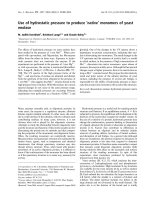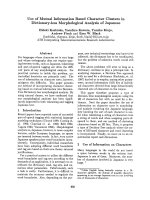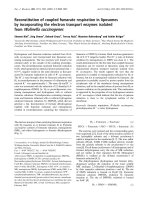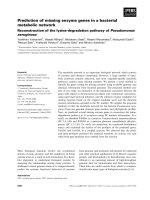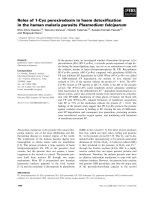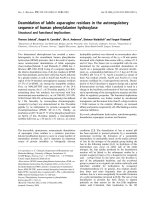báo cáo khoa học: " Use of the femoral vein (''''groin injecting'''') by a sample of needle exchange clients in Bristol, UK" ppt
Bạn đang xem bản rút gọn của tài liệu. Xem và tải ngay bản đầy đủ của tài liệu tại đây (217.18 KB, 5 trang )
BioMed Central
Page 1 of 5
(page number not for citation purposes)
Harm Reduction Journal
Open Access
Research
Use of the femoral vein ('groin injecting') by a sample of needle
exchange clients in Bristol, UK
John Maliphant
†1
and Jenny Scott*
†2
Address:
1
Bristol Drugs Project, 11 Brunswick Square, Bristol, BS2 8PE, UK and
2
Dept Pharmacy & Pharmacology, University of Bath, Bath, BA2
7AY, UK
Email: John Maliphant - ; Jenny Scott* -
* Corresponding author †Equal contributors
Abstract
Background: Use of the femoral vein for intravenous access by injecting drug users (IDUs) (commonly called 'groin injecting')
is a practice that is often observed but on which little is written in the literature. The purpose of this study was to describe self-
reported data from a sample of groin injectors on the natural history and rationale regarding their groin injecting, to inform
future research and the development of appropriate harm reduction strategies.
Methods: A convenience sample of groin injectors willing to participate in a semi-structured interview were recruited through
the Bristol Drugs Project Harm Reduction Service. The interviews were conducted over the period of one week. Data on
transition to groin injecting, rationale for use and incidence of problems were collected.
Results: Forty seven IDUs currently injecting in their femoral vein ('groin') were interviewed, 66% (n = 31) male and 34% (n =
16) female. Their mean age was 31 yrs (range 17 to 50 yrs; SD = 7.7). The mean length of time since first injecting episode was
9.6 yrs (range 6 mths to 30 yrs; SD = 7.0). The mean length of time since use of the groin began was 2.6 years (range 1 mth to
15 yrs; SD = 3.3). The mean length of time between first injection and first use of the groin was 7.0 yrs (SD = 7.0). One person
had used no other area for venous access prior to using the groin, nine people had used one, nine people had used two, 10
people had used three, five people had used four and 13 people had used more than four areas. The main reason given for
starting to inject in the groin was that 'no other sites were left'. However further discussion identified this meant no other
convenient sites were accessible. Practises such as the rotation of injecting sites, as advocated in many harm reduction leaflets,
were reported to be difficult and unreliable. The risk of missing the vein and subsequently losing the 'hit' was considered high.
Use of the non-dominant hand to administer injections was problematic and deterred rotation between arms. The groin site
was reported to be convenient, provide quick access, with little mess and less pain than smaller more awkward veins. The
formation of sinuses over time facilitated continued use of the groin. Approximately two thirds of participants had experienced
difficulty gaining IV access at their groin. Common problem included scar tissue occlusion, swelling and pain. Some reported
infections and past history of deep vein thrombosis.
Conclusion: Use of the groin was perceived to be convenient by the study group. Problems following safer injecting advice
were identified, including dexterity difficulties leading to fear of losing the 'hit'. Health problems at the groin site did not deter
use. These results suggest further qualitative work is needed to explore the difficulties in following safer injecting advice in more
detail and inform the development of more appropriate advice. Further quantitative work is necessary to establish the
prevalence of groin injecting amongst IDUs and the incidence of associated problems. There is a need for a longitudinal study
to examine the relationship between injecting technique and loss of patency of veins. If protective factors could be identified,
evidence-based safer injecting advice could be established to preserve peripheral veins and reduce use of the groin site, which
is high risk and associated with serious adverse consequences.
Published: 15 April 2005
Harm Reduction Journal 2005, 2:6 doi:10.1186/1477-7517-2-6
Received: 04 February 2005
Accepted: 15 April 2005
This article is available from: />© 2005 Maliphant and Scott; licensee BioMed Central Ltd.
This is an Open Access article distributed under the terms of the Creative Commons Attribution License ( />),
which permits unrestricted use, distribution, and reproduction in any medium, provided the original work is properly cited.
Harm Reduction Journal 2005, 2:6 />Page 2 of 5
(page number not for citation purposes)
Background
The physical health complications of injecting drug use
are well documented in the literature (e.g.[1-6]). The
injections used by injecting drug users (IDUs) are non-
sterile and not subject to quality control. This, coupled
with frequent, chronic venous administration is associ-
ated with damage to the vascular structure. Vascular dam-
age commonly begins with thrombophlebitis, leading to
vein sclerosis and loss of patency [1,3], rendering the vein
unusable. This leads to the IDU seeking other useable
points of intravenous (IV) access.
There is little research literature reporting patterns of vas-
cular access in IDUs. If the natural history of IDU injecting
patterns was better understood, effective strategies to pro-
tect vascular health could be explored. A paper by Darke
et al [7] describes a pattern of use of various injecting sites
over time, identified amongst a sample of injecting drug
users in Sydney, Australia. The authors report most injec-
tors began their injecting careers using the cubital fossa
(inner crook of the arm), with a pattern of progression
through forearm (after a median of two yrs from first
injection), upper arm (3.5 yrs from first injection), hand
(4 yrs from first injection), neck, feet, leg (all 6 yrs after
first injection) and finally groin and peripheral digits
(both 10 yrs from first injection). This suggests that use of
the groin amongst this sample was reserved as a 'last
resort' with other points of access being selected first.
The use of the femoral vein in the groin by IDUs is of con-
cern. It is linked with increased risk of vascular complica-
tions such as deep vein thrombosis (DVT), leg ulcers and
vascular insufficiency. Its close proximity to the femoral
artery and nerve also poses the risk of inadvertent trauma
to these sites. Arterial injection is associated with arterial
spasm and arterial thrombus formation [8].
The literature contains reports of adverse consequences
from use of the groin site but little qualitative study of the
factors that motivate this practice. The primary purpose of
this study was to inform service development at Bristol
Drugs Project (BDP) and compare the findings with that
of Darke et al
5
. However the findings of this work are of
interest to the wider harm reduction community because
little is written in the literature about groin injecting. This
study begins to shed some light on factors that motivate
this practice. It also suggests future areas for research
around groin injecting in order to inform the develop-
ment of evidence-based safer injecting advice.
Methods
Location
This study was undertaken in Bristol, which is the largest
city (pop. 382,000) in the South West region of England,
UK. Participants were clients of BDP, which is a voluntary
sector drug service. BDP is the only needle exchange and
harm reduction agency in the city, but there are also phar-
macy-based exchanges.
Recruitment
A convenience sampling method was used. Willing partic-
ipants were recruited from attendees at BDP needle
exchange base which is a fixed site service, and the Mobile
Harm Reduction Service, which is a vehicle providing out-
reach needle exchange services across the city. Data was
collected over a period of one week in 2004 by the same
interviewer in all cases. All clients who used the needle
exchange services staffed by the interviewer were invited
to take part in the study. Participants were guaranteed
strict confidentiality and data was collected anonymously.
Data collection
Data was gathered using a short semi structured interview
based on a series of questions derived from previous dis-
cussions amongst needle exchange clients and staff. It
explored injecting history and whether the person had
ever or was currently experiencing problems using their
groin. The study was reviewed and approved by the BDP
management board. The interview was conducted after
the needle exchange transaction was completed. Verbal
consent was obtained. Data was recorded on a tick-box
data collection form by the interviewer and by additional
note writing.
Analysis
Data was coded and input into SPSS for Windows (v. 12,
SPSS inc. Illenois, 2003) for analysis where appropriate.
Descriptive data was analysed to identify emergent
themes.
Results
Incidence of use of the groin and demographics
The interview took approximately 10 minutes. A total of
92 clients were interviewed as part of the wider review and
47 (51%) of these were currently injecting in their groin.
None of those who were not injecting in the groin pres-
ently had ever done so in the past. Of those injecting in
their groin, 66% (n = 31) were male and 34% (n = 16)
were female. The mean age of the groin injectors was 31
yrs (SD = 7.7), with the youngest being 17 and the oldest
being 50 yrs. Twelve (26%) of the groin injectors were
between 17–24 yrs, 29 (62%) were between 25 and 39 yrs
and 6 (13%) were between 40–50 yrs.
Length of time injecting
The mean length of time since first injecting episode was
9.6 yrs (SD = 7.0), with the shortest time since first inject-
ing episode being 6 months and the longest time being 30
yrs. Seventeen (36%) had been injecting 5 yrs or less, 12
(26%) had been injecting between 6 and 10 yrs, 10 (21%)
Harm Reduction Journal 2005, 2:6 />Page 3 of 5
(page number not for citation purposes)
had been injecting 11–15 yrs, 6 (13%) had been injecting
16–20 yrs, one (2%) had been injecting for 25 years and
one (2%) for 30 years.
Length of time of groin injecting
The mean length of time since use of the groin site began
was 2.6 years (SD = 3.3), with the shortest time being 0.08
years (1 month) and the longest time being 15 years. The
mode length of time was 2 years, reported by 6 people
(13%).
Time from first injecting episode to first use of the groin
The mean length of time between first injection and first
use of the groin for IV access was 7.0 yrs (SD = 7.0). Two
people (4%) had been using the groin for IV access since
they first began injecting, both were male. One had tried
to inject into the arms unsuccessfully prior to using the
groin, so switched to the groin straight away. This person
was very thin with no visible veins, so chose to use the
groin to ensure IV access. The other person had not tried
any other injecting sites prior to the groin, as all his asso-
ciates who were injecting at the time were using the groin,
encouraging him not to attempt to try any others first.
Twenty five people (53%) had begun using the groin
within 5 years from their first injection and 11 (23%) had
begun using the groin 5 or more yrs but less then 10 years
since their first injection. Eleven people (23%) had begun
using the groin 10 or more yrs since their first injection.
The longest time between first injection and use of the
groin was 23 yrs in a male who had begun injecting 25 yrs
ago but only started using the groin 2 yrs ago.
Areas used prior to the groin
People were asked to report which areas they had injected
into prior to using the groin. One (2%) person had used
no other area for venous access prior to using the groin
and had been using this site for 15 years. Nine (19%) peo-
ple had used one other area and in all cases this was the
cubital fossa (inner crook of the arm). Nine (19%) people
had used two areas prior to the groin, all of these cases had
used the cubital fossa, seven had also used site(s) on the
legs, one had used the foot and one had used the neck.
Ten (21%) people had used three areas prior to using the
groin. Again in all cases the cubital fossa had been used,
nine of the ten had used sites on the legs, six had used the
feet and five had used the neck. Five (11%) people
reported injecting in four areas prior to the groin. All had
used the same four areas, which were the cubital fossa,
legs, feet and neck. Thirteen (28%) people had used more
than four areas prior to the groin and classed themselves
as having used 'everywhere'.
Why did you start injecting in your groin?
The main reason given for starting to inject in the groin
was that 'no other sites were left'. However as many peo-
ple had not tried all other sites, this was probed further.
Further discussion found that in the majority of cases, no
other convenient sites were perceived to be accessible.
Many reported that practises such as the rotation of inject-
ing sites, as advocated in many harm reduction publica-
tions, were found to be difficult and unreliable. The risk
of 'losing' an injection (missing IV access) through poor
injecting technique was considered to be too big a risk,
presumably because subcutaneous and intramuscular
drug absorption does not provide the same euphoria. Use
of the non-dominant hand to administer injections was
also reported to be difficult and deter rotation of injecting
sites between arms, or require third party assistance. The
groin site was reported by most to be convenient, provide
quick access, with little mess and less pain than smaller
more awkward veins. The gradual formation of sinuses in
the groin over time was reported to further facilitate con-
tinued use of this site.
Drugs injected into the groin and equipment used
The most common drug injected by the group was heroin,
used by 46 (98%) of interviewees. Nineteen people (40%)
injected crack cocaine and eight (17%) injected ampheta-
mine. Twenty four people (51%) currently injected one
main drug only into the groin, with 23 injecting heroin
and one injecting amphetamine. Twenty people (43%)
injected two main drugs into the groin, for 16 of these
people their main drugs were heroin and crack cocaine.
The remaining four injected heroin and amphetamine.
Three people injected three main drugs into the groin and
for all these were heroin, crack cocaine and amphetamine.
No other drugs were reported to be injected into the groin
within the group.
The most common injecting equipment used to access the
groin was detachable 1 ml syringes with orange needles
(0.5 × 25 mm, 25G) used by 33 people (70%), 11 people
(23%) used the same syringes with blue needles (0.6 × 30
mm, 23G) and one person (2%) used green needles (0.8
× 40 mm, 21G). Seven people (15%) used 1 ml insulin
syringes. Numbers exceed 100% as four people regularly
used more than one type of equipment for groin access.
Condition of the groin site and history of access problems
Participants were asked whether they were currently or
had in the past experienced any problems gaining IV
access using the groin site. They were also asked to self-
assess the current condition of their groin based on a five
point Likert scale: 'very poor', 'poor', 'OK', 'good' or 'very
good'.
Approximately one third of people reported never having
had a problem gaining IV access at their groin site (n = 16,
34%). This group comprised 11 males and five females.
Five described the current state of their groin site as 'ok',
Harm Reduction Journal 2005, 2:6 />Page 4 of 5
(page number not for citation purposes)
five said it was 'good' and six said it was 'very good'. Their
mean length of use of the groin site was 1.1 yrs (SD = 1.2).
Approximately two thirds of people had experienced
problems with IV access at the groin site on one or more
occasions in the past, or were currently experiencing prob-
lems (n = 31, 66%). This group comprised 20 males and
11 females. When asked to describe the current condition
of their groin two said it was 'very poor', seven said it was
'poor', 14 described it as 'ok', three said it was 'good' and five
said it was 'very good'. Their mean length of use of the groin
site was 3.3 yrs (SD = 3.8).
When asked to describe the types of access and health
problems experienced, a common problem reported was
hardened scar tissue occluding the site. This was said to be
difficult to penetrate and a cause of needles bending and
breaking, causing some people to select longer, thicker
needles. Another common problem was swellings in the
groin area, accompanied at times by pain. Some people
reported infections at the injecting site. Some reported
having experienced 'blood clots' or 'DVT' (deep vein
thrombosis). It is unknown whether these had been med-
ically diagnosed or treated.
Discussion
It is of interest that in the overall sample (n = 92) all those
who had tried groin injecting (n = 47) continued to do so,
despite two thirds having experienced problems with
access and a range of health problems at the site. These
included reports of infections, hardened tissue, swelling
and DVT, which is consistent with problems described in
the literature. Further exploration of factors that discour-
age use of the groin amongst non groin injectors would be
of interest. Comparisons between vein health and inject-
ing practices of groin injectors and those who do not
inject in the groin would establish protective factors. A
longitudinal study is necessary for this to establish the fac-
tors that protect and damage the patency of veins. Modifi-
able protective factors could inform safer injecting advice.
The average length of time of groin injecting amongst the
sample was 2.6 years with the longest time being 15 years,
illustrating that this site of access can be used for consid-
erable time. The formation of sinuses around hardened
scar tissue was seen to be an advantage and facilitated con-
tinued use, despite posing the risk of breaking needles.
Further work to explore responses to problems with the
groin site and long-term consequences would be of inter-
est.
Darke et al [7] reported an average time of 10 years from
first injection to use of the groin site in their sample of
IDUs in Sydney. In this study the average length of time
from first injection to use of the groin site was 7 yrs, with
more than half (53%) of participants having begun groin
injecting within 5 yrs. One theory for the earlier use of the
groin site in Bristol is that the use of acidifiers such as citric
acid, necessary to dissolve the brown base heroin com-
mon in Western Europe, shortens the usable life of veins.
Acidifiers are not used in Australia as street heroin is in a
soluble form. However further work would be needed to
confirm is this theory is true.
A pattern of use of various sites prior to the groin site was
found in the majority in this study, similar to the findings
of Darke et al [7]. However in this study there were some
for whom rapid progression to use of the groin occurred,
for example nine participants had only used one site, the
cubital fossa, prior to the groin and a further nine had
only used two sites. The qualitative data gathered from the
sample illustrated that the groin was viewed as 'easy-to-
use' with more security of delivering the injection intrave-
nously than other, more awkward sites. This study
showed that the groin site was favoured over others for
utility and convenience. Other useable sites did poten-
tially exist in many, such as the cubital fossa of the domi-
nant arm, but were viewed as difficult to use and risked
loss of the injection. A need for safer injecting information
was highlighted in many in this study and practice within
the agency has been developed to address this. Future
work should examine decision making around use of the
groin and whether information on health risks coupled
with support to access more awkward peripheral veins can
deter use of the groin. However caution is needed not to
promote use of sites that require third party assistance, as
this may reduce the level of control the IDU has over the
injecting process and increase the risks of transmission of
hepatitis C and other blood-borne pathogens.
Several points can be learned from this work to inform the
delivery of harm reduction messages to this client group:
1. Recognition of the importance of utility and convenience
when selecting an injecting site. Had this study not
enquired about previous sites used and probed those who
said they had 'no other sites' left, it may have been
wrongly assumed that they did indeed have no useable
sites. The identification of the 'utility and convenience'
factor and the difficulties in using the non dominant hand
for drug injecting has prompted the authors to consider
the implementation of structured safer injecting training
for IDUs, in order to deter use of the potentially high risk
groin site. Such training, run by experienced nurses or
anaesthetists, could develop injecting skills amongst IDUs
in order to improve injecting techniques and promote the
use of other available peripheral sites on the upper limbs.
Such services could be integrated within safer injecting
facilities.
2. The data on choice of injecting equipment is encourag-
ing, as the majority of participants used detachable nee-
Publish with BioMed Central and every
scientist can read your work free of charge
"BioMed Central will be the most significant development for
disseminating the results of biomedical research in our lifetime."
Sir Paul Nurse, Cancer Research UK
Your research papers will be:
available free of charge to the entire biomedical community
peer reviewed and published immediately upon acceptance
cited in PubMed and archived on PubMed Central
yours — you keep the copyright
Submit your manuscript here:
/>BioMedcentral
Harm Reduction Journal 2005, 2:6 />Page 5 of 5
(page number not for citation purposes)
dles, which are intended for intravenous access. Most also
chose to use short needles (orange), which it is believed to
reduce the extent of vascular assault when injecting. This
practice has been promoted by needle exchange workers
locally. However the identified use of insulin syringes and
longer needles (e.g. blue) in some is of concern. Insulin
syringes are fragile and intended for subcutaneous use
only hence carry a risk of breaking, especially if scar tissue
forms that is tough to penetrate. Longer needles may
increase the assault on the vascular system or increase the
risk of injuring the surrounding nerves or arteries.
3. The contribution of the quantities, frequency of inject-
ing and poly drug use to vascular damage should be stud-
ied. Due to tolerance to the effects of many psychoactive
drugs, injectors often use increasing quantities and inject
with increasing frequency as their injecting careers
lengthen. Some also progress to poly drug use. Just over
half of this sample (51%) injected one drug only, and in
all but one cases this was heroin with the remaining case
being amphetamine. However of the remaining 49% (n =
23) who injected more than one drug, 19 were injecting
crack cocaine. Cocaine is a potent local anaesthetic and
could potentially increase the risks of using the groin site
(and other sites) due to lack of sensation on injecting. Fur-
ther work is needed to quantify and explore these risks
and also to assess the longevity of intravenous access in
relation to single and poly drug use and frequency of use.
This study focused on the practices of groin site injectors
in Bristol using the BDP needle exchange services, illus-
trating past and current injecting practices, identifying
learning points for safer injecting advice delivery and
future research. A convenience sample was used and the
sample size was dictated by willingness to participate in
the given time frame of the study. The results should not
be extrapolated to the rest of the UK or those not in con-
tact with BDP.
Conclusion
This study found, amongst a convenience sample of IDUs
in Bristol, that the average time from first injection to use
of the groin site was 7 yrs, with the majority having begun
use of this site within five years. Reasons for use of the
groin site centred on utility, convenience, ease of use and
reduced risk of losing the euphoric effects due to extrave-
nous delivery. Several key points were generated to inform
the BDP harm reduction service, including the idea of
developing safer injecting workshops for IDUs and
encouragement that messages on use of equipment were
successful. Several areas for future research have been
prompted by this study. Groin site injecting is a risky prac-
tice that appears to have had little mention in the litera-
ture other than the reporting of case studies. The health
risks are significant therefore further work to better under-
stand this practice amongst IDUs and how to deter it
would be of benefit.
Competing interests
The author(s) declare that they have no competing inter-
ests.
Authors' contributions
The questionnaire was developed on the basis of discus-
sion between the two authors and staff at BDP. JM, who is
employed by BDP, conducted the interviews. JS entered
and analysed all the data and drafted the first version of
this paper. Both authors contributed towards the revision
of this paper and production of the final draft.
Acknowledgements
Sincere thanks go to all the service users who took part in the interviews
and to Dr M Weiss, University of Bath for her comments on an earlier
draft.
References
1. Cherubin C, Sapira JD: The Medical Complications of Drug
Addiction and the Medical Assessment of the Intravenous
Drug User: 25 years later. Annals of Internal Medicine 1993,
119(10):1017-1028.
2. Selwyn P: Illicit Drug Use Revisited; What a Long, Strange
Trip It's Been. Annals of Internal Medicine 1993, 119(10):1044-1046.
3. Stein MD: Medical Complications of Intravenous Drug Use.
Journal of General Internal Medicine 1990, 5(3):249-257.
4. Haverkos H, Lange R: Serious Infections Other Than Immuno-
deficiency Virus Among Intravenous Drug Abusers. The Jour-
nal Of Infectious Diseases 1990, 161:894-902.
5. Levine DP: Skin and Soft Tissue Infections in Intravenous Drug
Users. In Infections in Intravenous Drug Users Edited by: Levine DP,
Sobell JD. Oxford University Press, New York; 1991:183-207.
6. Morrison A, Elliott L, Gruer L: Injecting-related Harm and
Treatment-seeking Behaviour Among Injecting Drug Users.
Addiction 1997, 92:1349-1352.
7. Darke S, Ross J, Kaye SL: Physical Injecting Sites Among Inject-
ing Drug Users in Sydney, Australia. Drug and Alcohol Depend-
ence 2001, 62:77-82.
8. Woodburn KR, Murie JA: Vascular Complications of Injecting
Drug misuse. British Journal of Surgery 1996, 83(10):1329-34.

